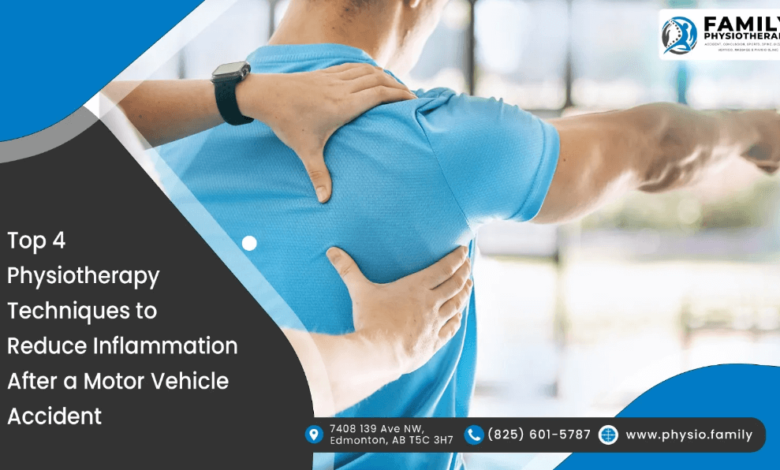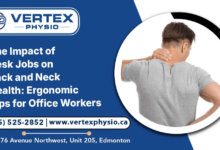Top 4 Physiotherapy Techniques to Reduce Inflammation After a Motor Vehicle Accident

Inflammation is a common issue following motor vehicle accidents (MVA), often resulting in pain, stiffness, and restricted movement. Motor vehicle accident physiotherapy Edmonton is designed to not only reduce inflammation but also prevent future flare-ups by strengthening the affected areas and improving flexibility. Through a combination of tailored exercises and therapeutic techniques, the body’s healing capacity is optimized. MVA physical therapy helps improve circulation, which plays a key role in minimizing inflammation and promoting tissue repair.
These key physiotherapy techniques are designed to alleviate discomfort, enhance mobility, and accelerate healing by addressing the root causes of inflammation.
1. Manual Therapy Techniques
Manual therapy is a key component of physiotherapy treatment that involves hands-on techniques aimed at relieving inflammation and promoting mobility. Here are some of the most effective manual therapy techniques for reducing inflammation after a motor vehicle accident:
Soft Tissue Mobilization
This technique manipulates muscles, tendons, and ligaments to enhance circulation, reducing inflammation. It helps loosen tight tissues and alleviates pain and stiffness caused by inflammation.
Joint Mobilization
Joint mobilization gently moves stiff, inflamed joints to improve the range of motion and minimize discomfort. It is particularly effective for addressing inflammation in the spine, neck, and shoulders.
Myofascial Release
By applying pressure to the fascia, this technique reduces inflammation and improves blood flow, helping to ease tension and restore mobility in affected areas.
Trigger Point Therapy
Targeted pressure is applied to release inflamed trigger points, reducing muscle tightness and pain. This approach is especially beneficial for managing inflammation in the neck, shoulders, and back.
2. Electrotherapy and Modalities:
It utilizes electrical currents to stimulate the muscles and nerves, providing pain relief and reducing inflammation. Here are some effective forms of electrotherapy used in physiotherapy:
TENS Therapy
TENS uses low-voltage electrical currents to block pain signals and reduce inflammation by stimulating nerves. This technique increases blood flow, helping to clear inflammatory substances and promote healing, especially in inflamed areas like the back, neck, and shoulders after an MVA.
Ultrasound Therapy
Ultrasound generates gentle heat through sound waves, improving circulation and reducing inflammation. It is effective for treating soft tissue injuries such as sprains and strains, promoting healing and easing inflammation.
Shockwave Therapy
Shockwave therapy delivers high-energy sound waves to inflamed tissues, stimulating healing and reducing inflammation. This method enhances circulation and collagen production, which is useful for muscle and tendon injuries.
Dry Needling
Dry needling targets trigger points to relieve muscle tension and inflammation. The needles improve blood flow, reducing inflammation and promoting healing in areas like the neck, shoulders, and lower back.
3. Therapeutic Exercise:
It is a crucial component of physiotherapy designed to improve mobility, strengthen muscles, and reduce inflammation. Specific exercises tailored to an individual’s injury can help alleviate pain and prevent re-injury. Here are some key exercises that help manage inflammation.
Range of Motion Exercises
Gentle range of motion exercises can be introduced early in the rehabilitation process to maintain joint mobility and reduce inflammation. These exercises focus on gently moving the affected joints through their full range, which helps to improve circulation and decrease stiffness caused by inflammation. For example, neck stretches and shoulder rolls are effective in reducing inflammation and maintaining mobility in the upper body after an accident.
Strengthening Exercises
As inflammation subsides, strengthening exercises become an important part of the recovery process. These exercises target the muscles enveloping the injured area, helping to support the joints and reduce the risk of further inflammation. Resistance bands and light weights can be utilized for exercises like shoulder presses, leg lifts, and core strengthening exercises. Strengthening weak muscles helps improve posture and stability, reducing the likelihood of ongoing inflammation.
Stretching Exercises
These are designed to improve flexibility and reduce muscle tightness, which can contribute to inflammation. Static and dynamic stretches target specific muscle groups, promoting relaxation and reducing the tension that often results from inflamed tissues. For example, hamstring stretches and chest openers are useful for alleviating tightness in the lower body and chest after an MVA, helping to reduce inflammation and improve mobility.
4. Taping and Bracing
Taping and bracing techniques are used to support injured joints and muscles, reducing inflammation and promoting healing. Here are some common taping and bracing methods used in physiotherapy:
Kinesiology Taping
Kinesiology tape supports muscles and joints while allowing movement, helping to reduce inflammation by improving blood flow and lymphatic drainage. It’s especially effective in reducing swelling and pain in the neck, shoulders, and lower back.
Rigid Taping
Rigid taping stabilizes joints by limiting excessive movement, reducing inflammation and preventing further injury. It’s useful for controlling swelling in areas like the knee or ankle.
Lumbar Support Brace
A lumbar support brace provides stability to the lower back, which is often affected in car accidents. By limiting excessive movement, it helps reduce inflammation and provides pain relief for lower back injuries.
Shoulder Brace
Shoulder braces offer support and immobilization for shoulder injuries. Limiting movement helps reduce inflammation and promotes healing, especially after dislocations or sprains.
Read also: Transforming Healthcare Operations with HubSpot
The Path to a Full Recovery:
Motor vehicle accident physiotherapy is essential for managing and reducing inflammation caused by injuries. Family physiotherapy Edmonton helps to control swelling, alleviate pain, and enhance faster healing by addressing the underlying causes of inflammation. Early intervention plays a huge role in preventing long-term complications; motor vehicle accident physiotherapy in Edmonton ensures that the injury doesn’t lead to chronic pain or mobility issues. With consistent treatment and proper care, individuals can regain their strength, restore mobility, and return to their daily activities with improved comfort and reduced inflammation.






